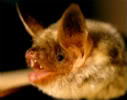The short-nosed fruit bat Cynopterus sphinx is the first bat species to have been observed engaging in oral sex.
New research headed by Min Tan of China’s Guangdong Entomological Institute discovered that female short nosed fruit bats would often lick the shaft of the male bats’ penis during penetration. Before this discovery published in PLoS ONE, only a few species—such as bonobos, orangutans, and, of course, humans—are known to engage in oral sex.
The activity of oral sex—always performed by the female bat on the male—was not rare, but happened in 70 percent of the recorded sexual instances. In addition Tan found that when the female bat engaged in oral sex, the act of penetration lasted longer: with on average of six seconds added to the copulation for every one second of fellatio. In addition, males never withdrew from the female when she was performing fellatio.
The sexual behavior of only a few bat species has been recorded due to the fact that the flying mammals are nocturnal and their roosts are often inaccessible to humans. Therefore, Tan went to great lengths to uncover the sexual behavior of her subjects. Tan and her team captured 60 short-nosed fruit bats, housed them, and filmed their sexual escapades after dark.
Fruit short-nosed bats are polygamous. The males craft tents out of foliage where females join them for copulation.
The researchers are not sure why these bats engage in fellatio, however they posit several theories, including that the oral sex by prolonging penetration may in some way increase the likelihood of fertilization. Or the oral sex could assist in preventing sexually transmitted diseases in the bats through antibodies in their saliva.
Citation: Tan, Min, Jones, Gareth, Zhu, Guangjiang, Ye, Jianping, Hong, Tiyu., Zhou, Shanyi, Zhang, Shuyi, & Zhang, Libiao. Fellatio by Fruit Bats Prolongs Copulation Time PLoS ONE, 2009, 4 (10) DOI: 10.1371/journal.pone.0007595
Related articles
Hunger drives great tits to kill and eat bats as they hibernate
(09/09/2009) A common bird in Europe, great tits tend to stick to insects and seeds as a food source with caterpillars as a particular favorite. However, a new paper in Biology Letters found that the song bird employs unique feeding behavior in a cave in Hungary: they kill and eat hibernating pipistrelle bats. This is the first instance ever recorded of a song bir preying on bats.
Moths defend against bats by ‘jamming’ sonar
(07/16/2009) Researchers have discovered a species of tiger moth that eludes bats by jamming their echolocation with ultrasonic clicks, a discovery that adds to the list of defensive mechanisms that insects use to defend themselves against bats. The study is published in the journal Science.
In the dark, bats identify each other by voice

(06/08/2009) Individual bats have the ability to tell the difference between other bats just by the sound of their voice, according to a study published in PLoS Computational Biology. Researchers from the University of Tuebingen, Germany found that the greater mouse-eared bat could distinguish between their fellows’ echolocation calls. A subject bat was tested by having to select between two others depending on their calls. The subject bats chose correctly over 80 percent of the time.